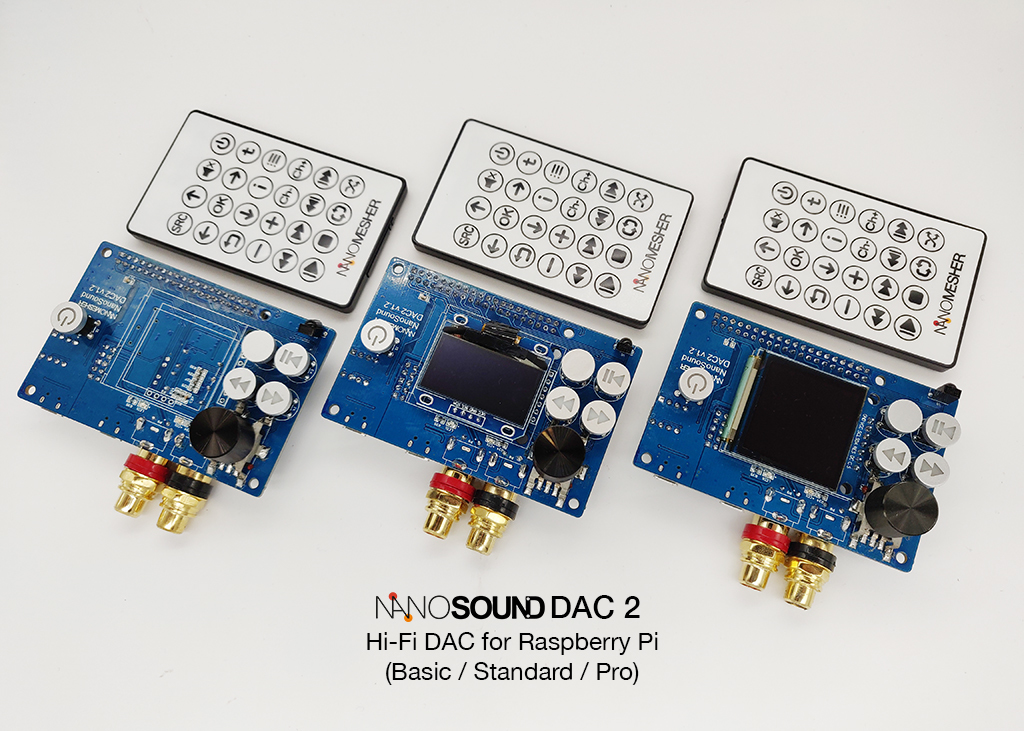This is a review and detailed measurements of the Nanomesher NanoSound DAC2 Raspberry Pi Audio solution. It was kindly sent to me by the company. It comes in three versions: basic, standard and Pro. The sample I have is the Standard and costs US $65.
Unlike other Pi DAC solutions, the NanoSound is not just a DAC. It comes with a display, remote control and ability to power the Pi on and off:

You connect the USB power to the DAC 2 and then you can power the whole thing on and off using the momentary power switch.
You have "transport" controls allowing you to skip forward/back, pause audio, etc.
I was given a Volumio microSD card to test. I inserted that in my Pi board and it all came up to life with nothing to do. Nanomesher provides video and instructions on how to create your own image.
I really liked having a display on a DAC/Pi. Without it, you boot the thing but have no idea if it is working or not. I know you can add such things to the Pi but it is nice to have it integrated on the DAC board.
There is a case that I think they sell to keep the unit protected. I did not like the look of it though.
I did not play with the remote. It is a card-like one with membrane switches:

Streamer DAC Audio Measurements
Testing of networked products is hard because Audio Precision analyzer can't control what they play. I had to queue up one file after another with no ability to run sweeps. So the test suite is limited.
Let's start with our dashboard:

I liked the volume control on DAC 2 and ability to get 2.1 volt output. Distortion and noise (SINAD) is typical of Pi Audio DACs and certainly below what we get in our good desktop DACs:

32-tone test is more hopeful:

We have about 16 bits of distortion-free range which is good enough for intended application.
Jitter test shows some components which suggest a 4 kHz jitter tone interfering:

That causes sidebands at +- 4 kHz relative to our tone at 12 kHz resulting in spikes at 8 and 16 kHz.
Conclusions
NanoSound DAC2 measurement performance is not that great in larger scope. Within budget category of Pi Audio DACs though, it is fairly typical. The value here is the extra functionality that the display and remote control bring with no integration work on behalf of the user. On that front, I can recommend the NanoSound DAC 2.
--------
As always, questions, comments, corrections, etc. are welcome.
It is the holiday season. So please, reach into your pocket and put in mine all that you find using: https://www.audiosciencereview.com/forum/index.php?threads/how-to-support-audio-science-review.8150/
Unlike other Pi DAC solutions, the NanoSound is not just a DAC. It comes with a display, remote control and ability to power the Pi on and off:
You connect the USB power to the DAC 2 and then you can power the whole thing on and off using the momentary power switch.
You have "transport" controls allowing you to skip forward/back, pause audio, etc.
I was given a Volumio microSD card to test. I inserted that in my Pi board and it all came up to life with nothing to do. Nanomesher provides video and instructions on how to create your own image.
I really liked having a display on a DAC/Pi. Without it, you boot the thing but have no idea if it is working or not. I know you can add such things to the Pi but it is nice to have it integrated on the DAC board.
There is a case that I think they sell to keep the unit protected. I did not like the look of it though.
I did not play with the remote. It is a card-like one with membrane switches:

Streamer DAC Audio Measurements
Testing of networked products is hard because Audio Precision analyzer can't control what they play. I had to queue up one file after another with no ability to run sweeps. So the test suite is limited.
Let's start with our dashboard:
I liked the volume control on DAC 2 and ability to get 2.1 volt output. Distortion and noise (SINAD) is typical of Pi Audio DACs and certainly below what we get in our good desktop DACs:
32-tone test is more hopeful:
We have about 16 bits of distortion-free range which is good enough for intended application.
Jitter test shows some components which suggest a 4 kHz jitter tone interfering:
That causes sidebands at +- 4 kHz relative to our tone at 12 kHz resulting in spikes at 8 and 16 kHz.
Conclusions
NanoSound DAC2 measurement performance is not that great in larger scope. Within budget category of Pi Audio DACs though, it is fairly typical. The value here is the extra functionality that the display and remote control bring with no integration work on behalf of the user. On that front, I can recommend the NanoSound DAC 2.
--------
As always, questions, comments, corrections, etc. are welcome.
It is the holiday season. So please, reach into your pocket and put in mine all that you find using: https://www.audiosciencereview.com/forum/index.php?threads/how-to-support-audio-science-review.8150/
